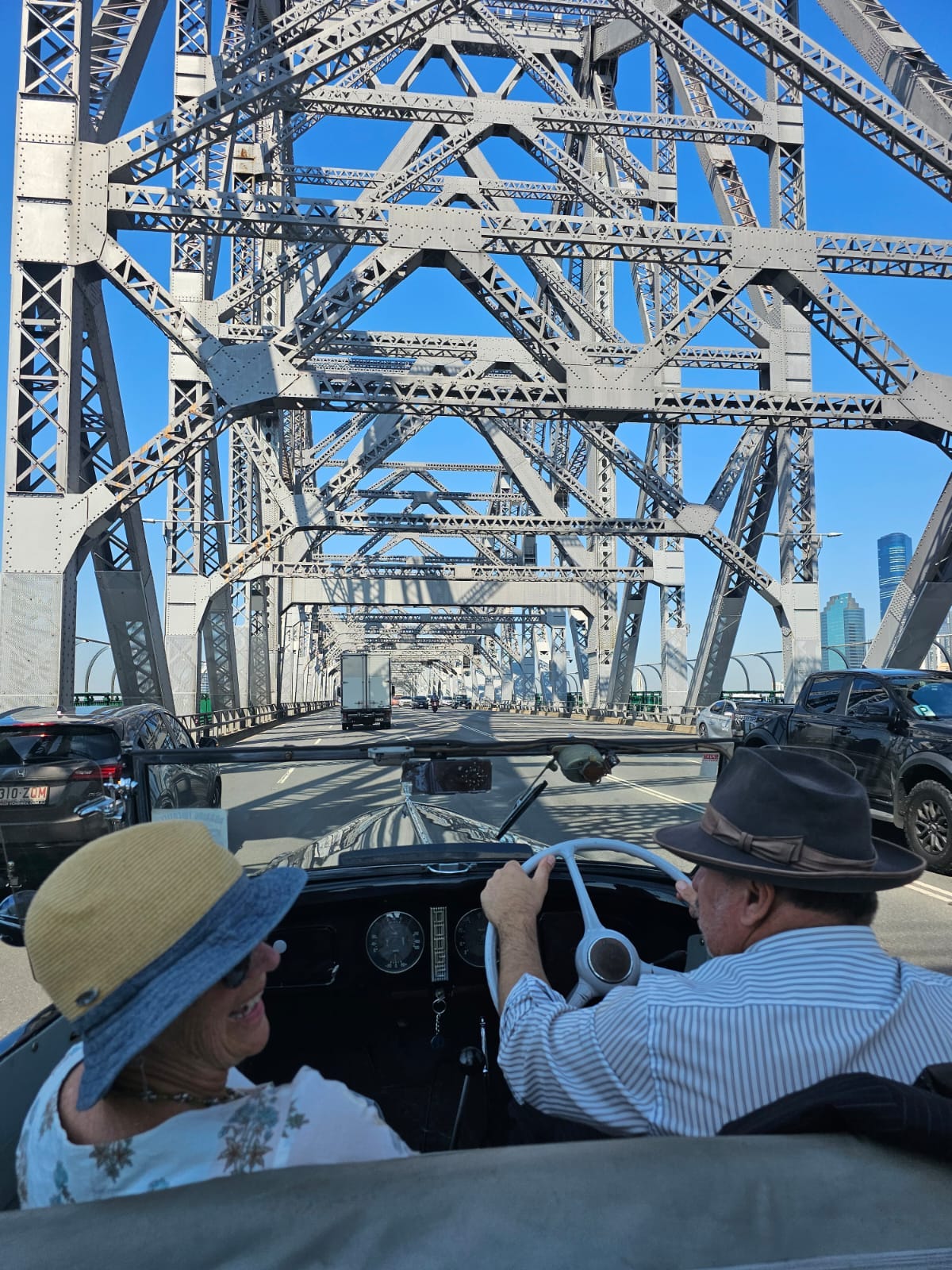A Bridge, A Car, and Art Deco Taught Me Why Quality Lasts
Time compounds what we invest in
This is me and Mo last week in his 1937 Dodge vintage car, driving over the 1940 Story Bridge in Brisbane, Australia.
I met Mo ten minutes earlier (a surprise birthday gift from my family).
The car was assembled in Brisbane.
The bridge is steel and is the longest cantilever bridge in Australia.
Driving around in his cool car, we drank in Mo’s stories about art, architecture, and the history of Art Deco in the city.
Wearing his fedora and pinstriped suit, Mo showed us 1930s homes and apartment buildings all over the adopted city he’s grown to adore.
With
no seatbelts
a 6-inch single, working windscreen-wiper
a windscreen that folded up for airconditioning
We motored at a gentle, stately, safe pace.
As if from another time.
And, if any stunned passersby complimented the car, Mo corrected them with a dry “This is an automobile.”
Quality stays in style
Quality sparkled in the simple design.
The seats were like a sofa. Mo’s wife described it as “driving your lounge room around town.”
Two dials on the dash. Stick shift. Lots of room.
The car’s body gleamed in the sunshine.
So, as we passed, heads turned.
Especially those heads old enough to recognise the era of this car.
Who noticed how stylish it was and how well preserved.
Just like the aging, iconic bridge we drove over.
Loved by locals and tourists too.
Which had also been under constant repair.
So it could continue to carry 100,000 cars a day from one side of the city to the other.
Because Australian bridges are designed to live for only 100 years.
And quality showed in the homes we visited. The simple lines, with zigzags and chevrons, of the Art Deco period.
Most were standing tall in their proud style, obviously well-tended.
A modern copy home built in 2017 showed that true style retains its charm and chutzpah.
Quality commands respect and care
The bridge, the buildings, and the automobile are all still in great working order many decades on.
Because they’re revered symbols of style.
They inspire love and respect for their creators from a past time.
Who had fewer tools than we do, but who, using what was available to them, took bold risks for the future.
Engineering risks.
Commercial risks.
Design risks.
The creators believed in their vision and went ahead.
Despite the naysayers and doubters of the time.
Despite being out of sync.
Despite no assurances.
Their boldness lives on.
And inspires those who love quality to preserve these creations still.
Time makes us care more
It got me thinking about the legacy we leave and how we care for quality things.
And how that care deepens over a long time.
Our creative process.
Our circle of friends and family.
Our planet.
And how
Where we give our time and attention shows what we value.
The quality of our care sustains the relationship.
Time compounds the love and the need to care.
Whether it’s a car, a building, or a bridge.
Or a relationship.
Or creative work.
The more we care, the more chance the thing we value has to continue.
And the more it continues, the more invested we are in it lasting.
And the more its value grows by itself.
It compounds.
Like any investment over time.
Compounding’s not just about money
So even if we can never be sure if something’s worth it or if it will last, we can’t help ourselves.
We create.
We design.
We dream.
We invest our energy and our time in making things better.
In creating something of quality.
And our relationships and works of art grow and flourish under our care.
We may never design a Dodge car. Or a story bridge. Or an Art Deco home.
But if we care enough to go for style and substance, we have a hope of being proud of our creations.
And when we care enough to learn and grow our skills, we feel satisfied with the improving quality of our work.
Care and quality go hand in hand.
They feed each other.
They make things last.
The takeaway
Whatever it is we’re building—a friendship, a business, a creative pursuit—let’s aim for quality.
That doesn’t mean letting perfectionism crush us.
Or hiding ourselves behind some imposter syndrome.
Or procrastinating until the ducks line up.
The bridge engineers, the architects, and the Dodge designers followed that bright spark.
They made it manifest into something beautiful.
And they left a legacy of style and quality that we still enjoy decades later.
So
Let’s not take shortcuts or hack our way ahead. It won’t be satisfying enough.
Let’s take the time needed for quality.
Let’s create something we’re proud of, even if it takes a while.
Let’s choose a worthy goal that we care about enough to stay the course.
Let’s believe that in a hundred years if someone heard about what we did, they’d be in awe.
That you’d be right in saying, “It’s not a car, it’s an automobile.”



